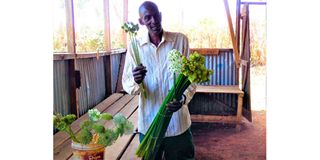Nyeri farmer's blooming flower business

Simon Muriuki displays some of his flowers.
What you need to know:
- Kenya is one of the biggest growers and exporters of cut flowers.
- In the UK, a significant proportion of cut flowers originate in Kenya.
Simon Muriuki, 47, who describes himself as a farmer by choice, not by chance, has been growing flowers for export for two years now, a business he is extremely happy with.
He grows Arabicum and Ammi majus varieties of flowers on two acres of land in Sagana, Nyeri County.
“For Arabicum, for instance, we grow the tubers, which take three and a half months to mature, after which you harvest the flowers for one and a half months, six weeks of consistent harvest. I harvest between 1,000 and 2,000 stems per week,” he says.

Simon Muriuki at his flower farm in Sagana, Nyeri County.
The flowers are graded according to length: 85cm and 80cm is rated as grade 1, 70cm grade 2, and 60cm grade 3. He sells 85cm flowers at Sh12, the 75cm at Sh8 and 60cm at Sh5.
“There are two seasons in this business, peak and off-peak. The best season is March, April and May, because it is winter where the flowers are exported, therefore those countries have no choice but to buy our flowers. I sell at an average of Sh8 per stem yearly,” says the farmer, who sells his flowers to Thika based firm, Wilmar Flowers.
He buys planting seeds at an average of Sh3,000 per bag, which contains 5 buckets of seeds. He plants 12 bags in a quarter acre, spending Sh36,000 on seeds. In total, he spends a capital of Sh45,000 in production of the flowers, inclusive of seeds, labour and other operation costs. After deducting the expenditure, he makes a profit of not less than Sh40,000 per quarter acre.
“If I get about 10,000 stems, and they go for Sh8 each, that is Sh80,000, I can therefore make a profit of Sh40,000 per quarter acre,” says the farmer.
Muriuki explains that the Ammi majus variety is not labour intensive. It is also cheap in terms of production since he propagates the seeds himself after harvesting, therefore he does not buy seeds.
“You simply sow the seeds directly on the farm, just like you would carrots, and after three-and-a-half months, you are ready to harvest.”

Simon Muriuki, left, with a worker sorting flowers.
For this flower, he gets between 100 and 200 stems per metre square, selling a stem at between Sh4 - Sh5.
He says that the highest cost of production for this variety of summer flowers is Sh15,000 per quarter acre. He manages to get Sh80,000 before deducting cost of production, and can make a profit of Sh55,000 after deducting the expenses.
Though the flower is easy to grow, it is prone to diseases such as early blight, which he controls by spraying.

An employee from Wilmar Flowers sorts flowers at Simon Muriuki’s farm.
Muriuki’s farm employs four casual workers: two harvesters, and two graders. He notes that since the crop is mainly grown for the export market, he and other farmers like him are able to access bank loans with ease, a factor that has gone a long way in growing their business.
The firm that buys his flowers has extended an agronomist who works with the farmers and collects information in terms of the crop quality, quantity, planting time, expected harvesting time and acreage that a farmer is using to grow the flowers.
Muriuki’s future plan is to buy a bigger piece of land, his vision to work on a 5-acre farm, which will earn him more, and also enable him to supply the local market.





